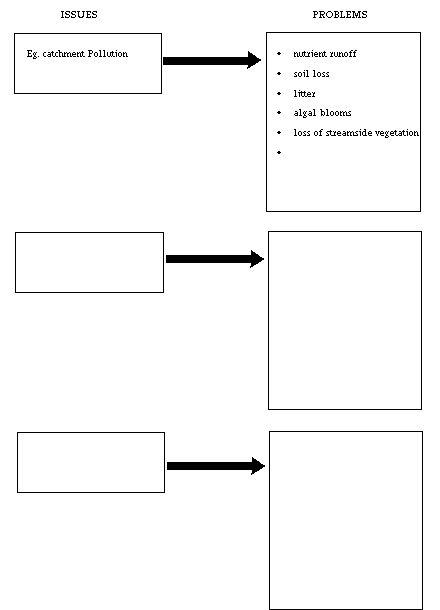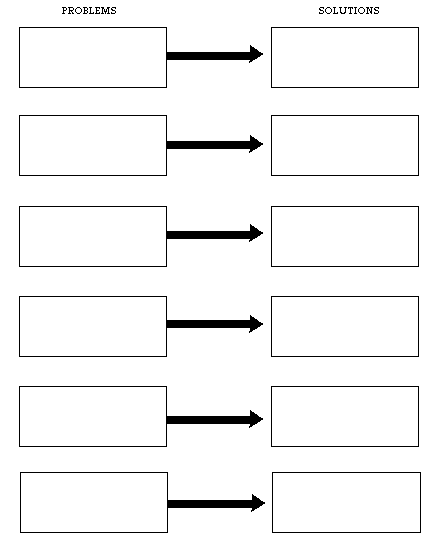Module 15 |
|
|||||||||||||||||||
|
Taking Action for the Coastal
|
|
|||||||||||||||||||
|
Resources |
|||||||||||||||||||
Resource 1
Resource 1 “Coastal and Marine Environment in Jeopardy”
Make up cards with the following statements and point values for the following categories OR make up your own. Suggested questions are given in brackets.
Catchment Connections
- 10 Points - When it rains water runs from the cities and towns to the sea using these drains .(What are stormwater drains?)
- 20 Points - These materials washed from the land to the sea are likely to persist in the ocean for many years. (What are plastics?)
- 30 Points - This material is a major source of faecal contamination of waterways. (What are dog droppings?)
- 40 points - These are the most common items found in beach washed litter near Australian cities. (What are cigarette butts?)
- 50 points - Increased algal blooms in bays and estuaries are often
associated with these soluble materials that are washed from the land
(What are nutrients?)
Ocean Blues
- 10 points - The rapid rise of sea level in the last century is thought to be caused by the increased concentration of this gas in the atmosphere. (What is carbon dioxide?)
- 20 points - This, often untreated material, from towns and cities flow from pipes and drains into the oceans around Australia (What is sewage?)
- 30 points - Large factory ships operating in the southern ocean have led to the marked decline in this fish species in the last twenty years. (What are southern blue fin tuna? Or What are Antarctic Tooth fish)
- 40 points - This is the source of most of the oil in the ocean. (What is land runoff containing oil off streets?)
- 50 points - These are the fish, birds, dolphins, seals, sharks, turtles and other animals that are often caught when using large indiscriminate nets for fishing (What is by-catch?)
Pollution Solutions
- 10 points - Extensive planting of trees by school students around a creek reduce the amount of this material washed down to the coast. (What is soil? litter? nutrients? runoff?)
- 20 points - These devices if used properly can prevent large amounts of solid materials entering the sea (What are litter traps)
- 30 points -This International Law for navigation, trade and the protection of the marine environment has been developed and ratified by the United Nations (What is the Law of the Sea?)
- 40 points -Washing the car on the lawn helps to reduce the amounts of this substance found in detergents entering waterways (What are phosphates?
- 50 points -These areas of the sea have been set aside for conservation, research, education, and to maintain marine ecosystems (What are Marine Parks? Reserves?)
Final Jeopardy Question
These are the three As for effective coastal and marine environmental
education.
(What are Awareness, Attitudes, and Action?)
Resource 2
Strategies for teaching Coasts and Marine studies
List learning strategies currently used for teaching students to care for marine and coastal environments in the left column of the table below. For each learning strategy, place an “X” in the appropriate column where it results in awareness, changing attitudes, or action.
The Three As of Coastal and Marine Studies
Awareness: Knowing about coastal and marine environments.
Attitudes: Recognising the importance of ecologically sustainable
development, the conservation value of coastal and marine environments,
and wanting to care for them.
Action: Practising the scientific skills to monitor and maintain the quality of coastal and marine environments, the social skills to negotiate issues of conflicting values, the practical skills to care for the coast and the sea, and the participatory skills needed to work with others to develop, implement and evaluate action plans to care for coastal and marine environments.
| Learning Strategies | Awareness | Attitudes | Action |
| eg. Field studies |
|||
| Research investigation |
|||
| Laboratory Studies |
|||
| Inquiry Learning |
|||
| Lectures |
|||
Resource 3
Issues and Problem Cards

Resource 4
Problems and Solutions Page
